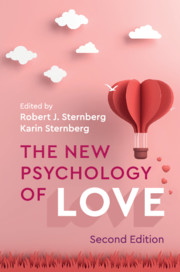Book contents
- The New Psychology of Love
- The New Psychology of Love
- Copyright page
- Dedication
- Contents
- Figure and Tables
- Contributors
- Preface
- Chapter 1 Love as Expansion of the Self
- Chapter 2 Entraining, Becoming, and Loving
- Chapter 3 The Evolution of Love in Humans
- Chapter 4 Neuroimaging of Love in the Twenty-first Century
- Chapter 5 Love Conceptualized as Mutual Communal Responsiveness
- Chapter 6 Love Is Political: How Power and Bias Influence Our Intimate Lives
- Chapter 7 Love, Desire, and Sexual Fluidity
- Chapter 8 Everyday Conceptions of Love
- Chapter 9 Passionate Love
- Chapter 10 Slow Love: Courtship in the Digital Age
- Chapter 11 Styles of Romantic Love
- Chapter 12 An Anthropologist Goes Looking for Love in All the Old Places: A Personal Account
- Chapter 13 A Behavioral Systems Approach to Romantic Love Relationships: Attachment, Caregiving, and Sex
- Chapter 14 When Love Goes Awry (Part 1): Applications of the Duplex Theory of Love and Its Development to Relationships Gone Bad
- Chapter 15 When Love Goes Awry (Part 2): Application of an Augmented Duplex Theory of Love to Personal and Situational Factors in Jealousy and Envy
- Index
- References
Chapter 3 - The Evolution of Love in Humans
Published online by Cambridge University Press: 03 December 2018
- The New Psychology of Love
- The New Psychology of Love
- Copyright page
- Dedication
- Contents
- Figure and Tables
- Contributors
- Preface
- Chapter 1 Love as Expansion of the Self
- Chapter 2 Entraining, Becoming, and Loving
- Chapter 3 The Evolution of Love in Humans
- Chapter 4 Neuroimaging of Love in the Twenty-first Century
- Chapter 5 Love Conceptualized as Mutual Communal Responsiveness
- Chapter 6 Love Is Political: How Power and Bias Influence Our Intimate Lives
- Chapter 7 Love, Desire, and Sexual Fluidity
- Chapter 8 Everyday Conceptions of Love
- Chapter 9 Passionate Love
- Chapter 10 Slow Love: Courtship in the Digital Age
- Chapter 11 Styles of Romantic Love
- Chapter 12 An Anthropologist Goes Looking for Love in All the Old Places: A Personal Account
- Chapter 13 A Behavioral Systems Approach to Romantic Love Relationships: Attachment, Caregiving, and Sex
- Chapter 14 When Love Goes Awry (Part 1): Applications of the Duplex Theory of Love and Its Development to Relationships Gone Bad
- Chapter 15 When Love Goes Awry (Part 2): Application of an Augmented Duplex Theory of Love to Personal and Situational Factors in Jealousy and Envy
- Index
- References
Summary
“Love is blind,” according to a common saying. “Love is a recent invention, a mere few hundred years old,” some social scientists have argued. “Love is limited to Western cultures,” according to others. This chapter explains why all these beliefs are radically wrong. From an evolutionary perspective, love is an adaptation, or more accurately a complex suite of adaptations, designed to solve specific problems of survival and reproduction.
- Type
- Chapter
- Information
- The New Psychology of Love , pp. 42 - 63Publisher: Cambridge University PressPrint publication year: 2018
References
- 13
- Cited by

